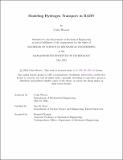Modeling Hydrogen Transport in BABY
Author(s)
Weaver, Colin
DownloadThesis PDF (16.48Mb)
Advisor
Ferry, Sara E.
Terms of use
Metadata
Show full item recordAbstract
Fusion energy stands as a beacon of hope in the realm of sustainable power generation, offering the potential to meet global energy demands without adverse environmental impacts. However, fusion power is not yet commercially viable, and significant research is still needed to develop the technologies necessary to make it a reality. Central to the realization of practical fusion reactors is the efficient management of tritium, a scarce and radioactive isotope that serves as the fuel in a deuterium-tritium fusion reaction. The liquid immersion blanket concept, pioneered by endeavors like Commonwealth Fusion Systems, represents a significant stride towards addressing the challenges of tritium breeding and extraction. At the forefront of this endeavor lies the LIBRA Experiment, the goal of which is to better understand tritium breeding, containment, and extraction under a fusion-like neutron spectra, and BABY, a scaled-down iteration of the LIBRA Experiment designed to serve as a stepping stone to the full LIBRA Experiment. BABY serves as a testbed for evaluating Tritium extraction mechanisms and assessing the feasibility of achieving self-sufficiency in fuel production within a fusion power plant environment. In this context, understanding hydrogen transport phenomena within the BABY system emerges as a crucial aspect of optimizing tritium extraction and ensuring tritium self-sufficiency. By employing advanced modeling techniques simulating fluid flow and heat transfer to inform tritium transport simulations in FESTIM, this thesis endeavors to elucidate the intricacies of hydrogen migration mechanisms, diffusion rates, and their impact on tritium dynamics within the molten salt environment of BABY. Steady state simulations of bulk tritium transport coefficients provide results for the range of tritium transport coefficients for BABY, while transient simulations provide insight into the complex dynamics surrounding tritium transport through the various surfaces of BABY. The findings of this study hold profound implications for the fusion energy landscape, offering valuable insights that can inform the design and operation of future fusion reactors utilizing liquid immersion blankets. By elucidating the factors governing hydrogen transport in BABY, this research aims to contribute to the overarching goal of achieving sustainable and efficient fusion energy production.
Date issued
2024-05Department
Massachusetts Institute of Technology. Department of Mechanical EngineeringPublisher
Massachusetts Institute of Technology